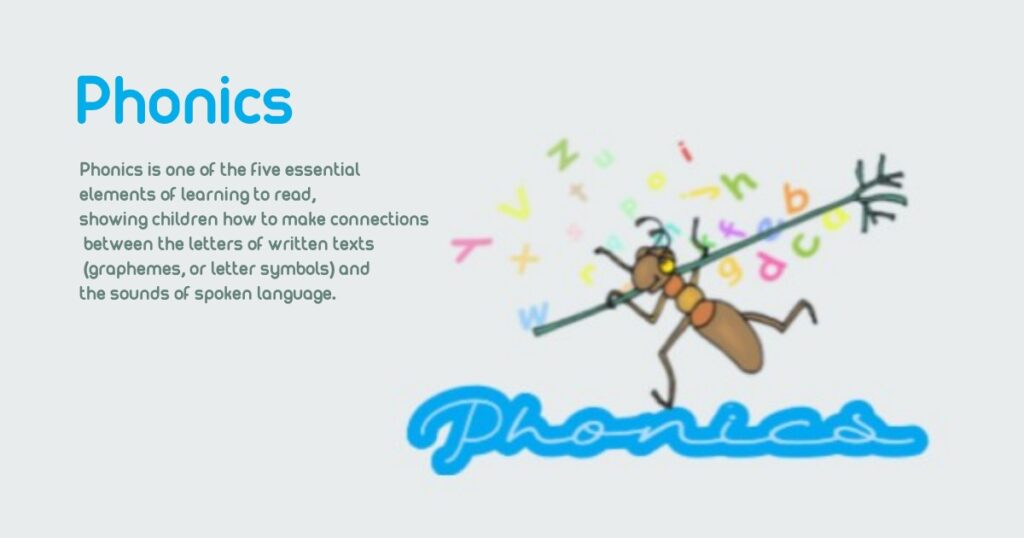Phonics Class

Unlock your child’s reading potential and set them on the path to literacy success with our fun and engaging phonics classes!

How we work …
Lessons
Here are some teaching materials that we use in an online kids’ phonics class:
- Interactive whiteboards or digital whiteboards for displaying phonics lessons, games, and activities.
- Digital books or e-books with phonetically controlled text reinforce decoding skills and sight word recognition.
- Online educational games and activities that focus on phonics concepts, such as letter-sound correspondence, word families, and syllable segmentation.
- Audio and video resources, such as phonics songs, chants, and rhymes, engage learners and reinforce phonics concepts.
- Printable phonics worksheets and activities that can be completed offline and used to reinforce concepts taught during class.
- Manipulatives, such as letter tiles or word cards, that can be used to create words and reinforce phonics concepts.
- Visual aids, such as pictures and graphics, to help learners associate letters and sounds with objects and actions.
- Digital quizzes and assessments to measure learners’ progress and understanding of phonics concepts.
- The materials used will depend on the age and learning style of the learners and the curriculum goals of the class. It’s important to have a variety of materials to engage learners and cater to different learning styles.
Coaching
Our online phonics teachers possess the following qualities:
- Strong knowledge of phonics: A good phonics teacher should have a thorough understanding of phonics concepts, including letter-sound correspondence, decoding skills, and sight word recognition.
- Patience and empathy: Young learners may struggle with phonics, so a good teacher should be patient and empathetic when working with students who are struggling.
- Engaging and interactive teaching style: To keep young learners engaged, a good phonics teacher should use a variety of teaching methods, such as games, songs, and interactive whiteboards, to make lessons fun and interactive.
- Clear communication skills: It is essential for a phonics teacher to communicate clearly and effectively with young learners, especially since they may be learning in a non-native language.
- Personalization and differentiation: Every learner has unique needs and learning styles, so a good phonics teacher should personalize instruction and differentiate materials to meet the needs of each student.
- Flexibility and adaptability: Online teaching can come with unexpected challenges, so a good phonics teacher should be flexible and adaptable, able to modify their teaching style and materials to meet changing needs.
- Encouraging and supportive: A good phonics teacher should provide positive reinforcement and encouragement to help students build confidence and feel motivated to learn.
- Overall, a good online phonics teacher should have a passion for teaching and a strong commitment to helping young learners develop foundational reading skills.
Group Activities
Here are some fun and engaging activities that we can use in an online phonics class for kids:
- Phonics games: Play interactive online games that focus on phonics concepts such as letter-sound correspondence, word families, and syllable segmentation. Examples include Hangman, Word Search, and Phonics Memory.
- Virtual Phonics Scavenger Hunt: Send students on a virtual scavenger hunt to find objects around their house that start with a certain letter or sound.
- Rhyming Word Puzzles: Provide students with a puzzle in which they have to match rhyming words together.
- Phonics Songs and Chants: Use fun phonics songs and chants to help reinforce concepts and improve pronunciation.
- Word Building: Provide students with letter tiles or cards and have them build words, either real or made-up.
- Interactive Stories: Use digital storybooks or read-aloud to expose students to phonetically controlled text.
- Picture Recognition: Show students pictures of objects and have them identify the beginning, middle, and ending sounds.
- Virtual Word Wall: Create a virtual word wall where students can add new words that they have learned during class.
- Decodable Text Practice: Have students read decodable text, either independently or with a partner, to practice their decoding skills.
- These activities are just a few examples of the many fun and engaging ways to teach phonics to young learners in our online setting.

The Course combines 3 pillars to unlock the benefits
Immersion

Strategy

Tactics


Here’s what you get …
Here are some learning objectives for an online phonics class for kids:
- Identify and recognize letters of the alphabet and their corresponding sounds.
- Decode and read simple CVC (consonant-vowel-consonant) words.
- Understand and apply phonetic rules for blending and segmenting words.
- Recognize and read high-frequency sight words.
- Identify and read words with common prefixes and suffixes.
- Develop fluency in reading phonetically controlled text.
- Build vocabulary and comprehension skills through exposure to age-appropriate phonetically controlled text.
- Write simple words using phonetic knowledge and conventions.
- Demonstrate an understanding of the relationship between letters and sounds through spelling and writing.
- Apply phonics knowledge to improve reading and writing skills.
These learning objectives align with common goals for teaching phonics to young learners, including developing foundational reading skills, building vocabulary and comprehension, and improving overall literacy abilities.

Invest in yourself today! Pick a plan…
Online Study
- Online course
- Answer questions by Email or live online periodically.
Group study
- Live online blended in-person tutoring
- Online course review
- One hour per day
Private Coaching
- One to One private tutoring
- Book an appointment to get a quote
